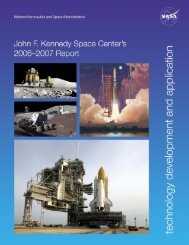Fall-Winter 2008 - Kennedy Space Center Innovative Partnerships ...
Fall-Winter 2008 - Kennedy Space Center Innovative Partnerships ...
Fall-Winter 2008 - Kennedy Space Center Innovative Partnerships ...
You also want an ePaper? Increase the reach of your titles
YUMPU automatically turns print PDFs into web optimized ePapers that Google loves.
Voltage Sensor Charged for Success<br />
A spark is all it would take to wreak<br />
havoc or catastrophe in the space<br />
program at any step along the way to launch.<br />
Static charge buildup causes problems for<br />
<strong>Kennedy</strong> <strong>Space</strong> <strong>Center</strong>’s (KSC’s) operations<br />
because of the flammability of fuels for<br />
rockets and the delicacy of spacecraft<br />
electronics. Static can build during the<br />
manufacturing process, and KSC needed a<br />
way to detect static charges generated after<br />
assembly workers entered a facility.<br />
QUASAR Federal Systems (QFS) developed<br />
a Remote Voltage Sensor (RVS) that can<br />
detect a potential charge of 100 volts from<br />
1 meter away. The device is small enough<br />
for workers to comfortably wear and has no<br />
moving parts, thus eliminating it as a charge<br />
source. The RVS consists of a dime-size<br />
sensor that can be affixed to a cap or collar<br />
to communicate with a control module about<br />
the size of a pager that can be clipped to a<br />
belt. The system, the first to allow practical,<br />
real-time monitoring and detection of<br />
electrostatic hazards at a distance, is portable,<br />
rugged, low power, and low cost. Its ability<br />
to alert workers to potentially explosive<br />
conditions could save lives.<br />
The Small Business Innovation Research<br />
(SBIR) and Small Business Technology<br />
Transfer (STTR) programs give small hightech<br />
companies and research institutions the<br />
opportunity to participate in governmentsponsored<br />
research and development. KSC’s<br />
SBIR partnership with QFS is one example.<br />
The SBIR Phase I feasibility study was<br />
completed in 2004; Phase II prototype<br />
development was accomplished in 2005 and<br />
2006. In 2007, the Department of Defense’s<br />
Defense Advanced Research Projects Agency<br />
(DARPA) heralded QFS for its advances to<br />
state-of-the-art defense technology.<br />
QFS, which has a patent pending for its<br />
RVS, has gone on to craft a strategic alliance<br />
with MKS Instruments, a global provider of<br />
instruments and subsystems that analyze and<br />
control critical parameters of manufacturing<br />
processes. MKS incorporated the RVS into<br />
its product line. The RVS system is finding<br />
success in sensitive manufacturing facilities<br />
such as those that produce semiconductor<br />
wafers and flat-panel displays. n<br />
The lightweight Remote Voltage Sensor enhances personnel<br />
safety and device protection. (photo courtesy of QUASAR Federal<br />
Systems, Inc.)<br />
Q&A<br />
Q: When should I file a new technology<br />
report (NTR)?<br />
A: The earlier the better.<br />
•AnNTRshouldbesubmittedassoonasyourecognizethat<br />
you have a new invention. This may occur in the middle of<br />
a project while R&D is still ongoing, or it may be during<br />
normal end-of-project reporting. The process of writing<br />
programmatic and mission progress reports also may assist<br />
you in recognizing and describing a new innovation.<br />
•Theearlieryourinventionisreportedtothe<strong>Innovative</strong><br />
<strong>Partnerships</strong> Program (IPP) Office, the more effectively<br />
and efficiently IPP can help protect NASA’s interest in the<br />
technology as well as seek external partners.<br />
•Evenifyourinventionis“justanidea,”filingtheNTRright<br />
away enables IPP to provide guidance and assistance.<br />
•Mostimportantly,youshouldsubmittheNTRbefore<br />
making any public disclosure of your innovation. Premature<br />
disclosure could result in NASA losing its rights to the<br />
invention, which jeopardizes partnership opportunities and<br />
eliminates the possibility of royalty payments to you and<br />
<strong>Kennedy</strong> <strong>Space</strong> <strong>Center</strong>.<br />
You can file your NTRs online at http://entre.nasa.gov. For<br />
more information, contact Lew Parrish in KSC’s <strong>Innovative</strong><br />
Partnership Program Office (Lewis.M.Parrish@nasa.gov or<br />
867-5033). n<br />
volume 1, number 2 | fall/winter <strong>2008</strong> | <strong>Innovative</strong> <strong>Partnerships</strong> Program<br />
sbir/sttr<br />
7













